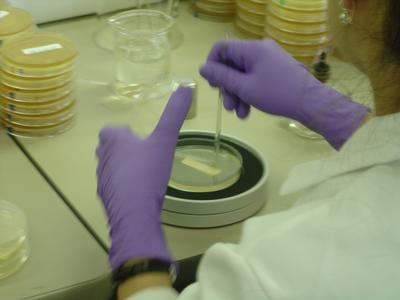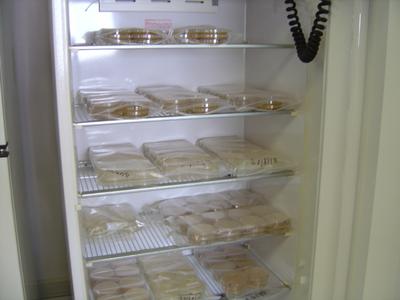28 November, 2003
Plating Our Samples
While yesterday was spent preparing the lab to process our soil samples,
today we started working with our samples. To start, 100g of each soil
sample was removed from the sample bag and placed into a sterile flask. If
we sampled at twelve different locations and collected three samples at
each location, how many flasks were needed? Sterile water was added to the
soil, and the soil was then placed in a shaker. A portion of this soil
solution will be plated directly on to the LB agar. We plated different
concentrations of each soil solution on to 3 LB plates. Some plates were
plated very concentrated, while others were diluted. Why would we want to
dilute when plating? Rusty gave the 3 LB plates 10ul, 50ul or100ul of soil
solution. If all plates were given a total of 100 microliters (ul) of
solution, how much water (if any) did he add to each plate?
Before we can plate on to YPD agar, it must be concentrated. To do this,
we transfer the soil solution into a falcon tube. This is then spun in a
centrifuge, allowing a pellet to form at the bottom. The liquid on top is
decanted and the pellet is resuspended in water. This solution is then
transferred on to the YPD plate using a pipette. Three plates were given
100ul of solution and three plates were given 200ul of solution. Why would
we want to plate multiple plates for each sample?

1. Regina pouring some of the soil solution from a flask into a tube. Why would we want to keep them on ice throughout the plating process? (Hint: what do we already know about the environment in which our critters live?)

2. Dr. Rusty Rodriguez using a pipette to transfer the soil solution on to the plate. For each new sample he must use a new, sterilized pipette tip. Why is this so important?

3. Regina sterilizing the glass spreader in an alcohol burner

4. Regina spreads the soil solution onto the plate. The plate can be spun around on the white turntable. For each sample, we plated 3 LB and 6 YPD plates. How many total plates did she plate? (Hint: you also have to know how many locations from which we sampled and the number of samples collected at each location)

6. Here is our freezer full of plates. Now, all we can do is wait. Can you tell which ones are for growing yeast and which ones are for growing bacteria?
Contact the TEA in the field at
.
If you cannot connect through your browser, copy the
TEA's e-mail address in the "To:" line of
your favorite e-mail package.
|
